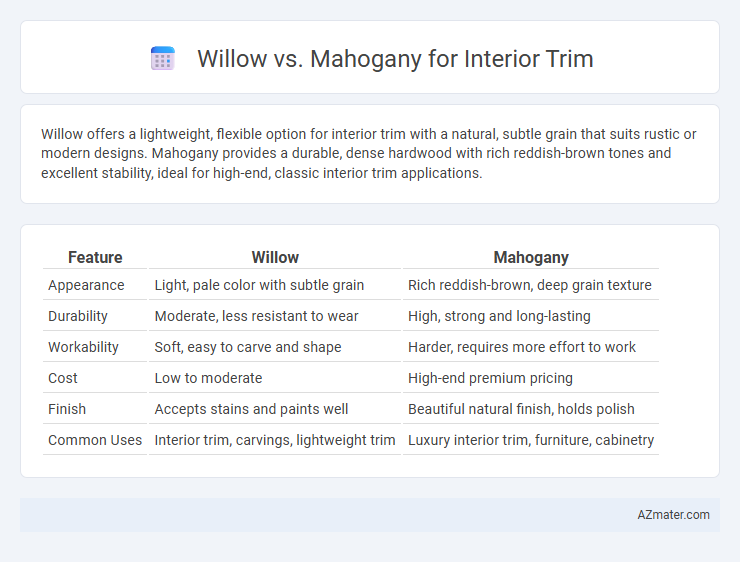Willow offers a lightweight, flexible option for interior trim with a natural, subtle grain that suits rustic or modern designs. Mahogany provides a durable, dense hardwood with rich reddish-brown tones and excellent stability, ideal for high-end, classic interior trim applications.
Table of Comparison
| Feature | Willow | Mahogany |
|---|---|---|
| Appearance | Light, pale color with subtle grain | Rich reddish-brown, deep grain texture |
| Durability | Moderate, less resistant to wear | High, strong and long-lasting |
| Workability | Soft, easy to carve and shape | Harder, requires more effort to work |
| Cost | Low to moderate | High-end premium pricing |
| Finish | Accepts stains and paints well | Beautiful natural finish, holds polish |
| Common Uses | Interior trim, carvings, lightweight trim | Luxury interior trim, furniture, cabinetry |
Introduction to Willow and Mahogany for Interior Trim
Willow wood offers a lightweight, affordable option with a pale color and subtle grain, ideal for casual or rustic interior trim designs. Mahogany, renowned for its rich reddish-brown hue and durability, provides a luxurious, classic look often preferred for high-end, traditional trim work. Both woods present unique textures and color profiles that influence the overall aesthetic and maintenance of interior spaces.
Visual Appeal: Color and Grain Differences
Willow wood features a light, creamy color with subtle grain patterns, creating a soft, understated aesthetic ideal for modern and minimalist interiors. Mahogany displays a rich, reddish-brown hue with pronounced, swirling grain that adds warmth and elegance, making it a popular choice for traditional and high-end designs. The distinct color depth and grain variation between willow and mahogany offer versatile options for tailoring interior trim to specific visual themes and moods.
Durability and Hardness Comparison
Willow wood offers moderate durability and a Janka hardness rating around 430, making it softer and more prone to dents and scratches compared to mahogany, which has a Janka hardness of approximately 900 to 900+ depending on the species, providing superior resistance to wear and impact. Mahogany's increased hardness ensures longevity and sturdy performance in high-traffic interior trim applications, while willow is more suitable for decorative trims with less physical contact. Choosing mahogany over willow enhances the trim's lifespan and maintains aesthetic integrity in demanding environments.
Cost and Availability of Willow and Mahogany
Willow is generally more affordable and widely available than mahogany, making it a cost-effective choice for interior trim projects. Mahogany is considered a premium hardwood with higher price points due to its durability and rich grain, but it may be less accessible depending on the supplier. Choosing willow can reduce overall expenses while still offering a lightweight and workable option, whereas mahogany provides a luxurious finish with a higher investment and limited availability in some regions.
Workability and Installation Considerations
Willow offers excellent workability due to its softness and fine grain, making it easy to cut, shape, and sand for interior trim applications. Mahogany, while harder and denser, requires sharper tools and more effort but provides superior durability and a smooth finish for intricate moldings and details. Installation of willow trim is generally faster and less labor-intensive, whereas mahogany demands careful handling to prevent splitting and may require pre-drilling for nails to ensure a flawless installation.
Maintenance Needs for Each Wood Type
Willow wood used for interior trim requires moderate maintenance due to its softer grain, making it more prone to dents and scratches, but it can be easily sanded and refinished. Mahogany offers superior durability with minimal upkeep, as its dense, stable grain resists warping and moisture damage, preserving its appearance over time. Both woods benefit from regular dusting and occasional polishing to maintain their natural luster and extend their lifespan in interior environments.
Environmental Impact and Sustainability
Willow offers a highly sustainable option for interior trim due to its rapid growth rate and low environmental impact, as it requires minimal pesticides and fertilizers. Mahogany, while prized for its durability and rich aesthetic, often raises sustainability concerns due to slower growth and overharvesting in tropical forests. Choosing willow supports eco-friendly building practices and reduces deforestation risks associated with mahogany harvesting.
Best Applications: Willow vs Mahogany in Home Styles
Willow wood excels in rustic and country-style interiors, offering a soft, light texture perfect for cottage and farmhouse trims due to its affordability and ease of staining. Mahogany is ideal for classic, traditional, and Victorian home styles, providing rich, deep reddish hues and exceptional durability that enhance formal and elegant spaces. Choosing between Willow and Mahogany depends on the desired aesthetic and budget, with Willow suiting casual, cozy environments while Mahogany complements luxurious, sophisticated interiors.
Pros and Cons of Willow Trim
Willow trim offers a light, natural appearance with fine grain that enhances interiors with a warm, contemporary feel. Its softness makes it easier to carve and shape, ideal for detailed moldings, but it may be prone to dents and scratches, reducing durability in high-traffic areas. Compared to mahogany, willow is generally more affordable and sustainable, though it lacks the rich color and hardness that mahogany provides for long-lasting, elegant finishes.
Pros and Cons of Mahogany Trim
Mahogany trim offers exceptional durability and a rich, warm appearance that enhances interior spaces with timeless elegance. Its resistance to decay and insects makes it ideal for long-lasting installations, though it is typically more expensive and harder to source sustainably compared to other woods like willow. The dense grain of mahogany also allows for smooth finishes and fine detailing but may require specialized tools for cutting and shaping.

Infographic: Willow vs Mahogany for Interior Trim
 azmater.com
azmater.com